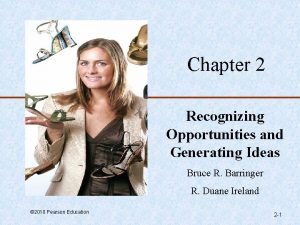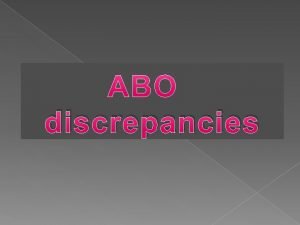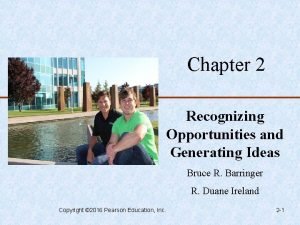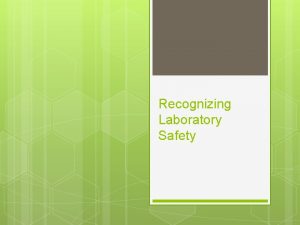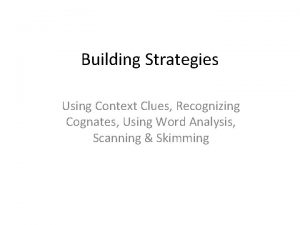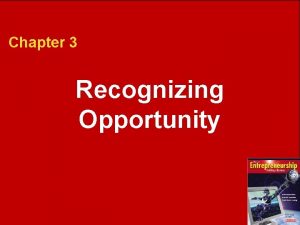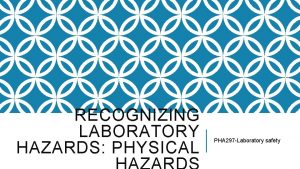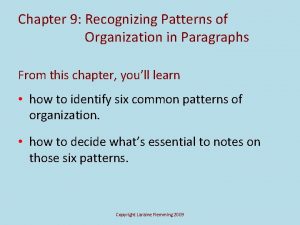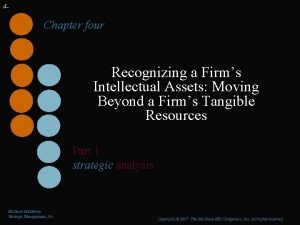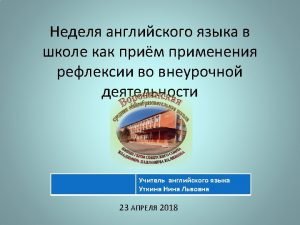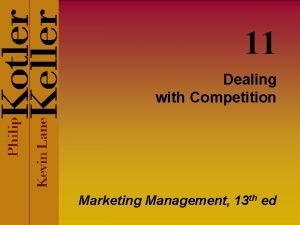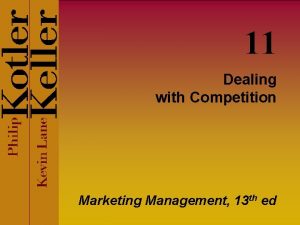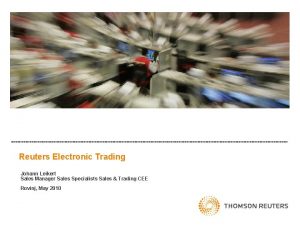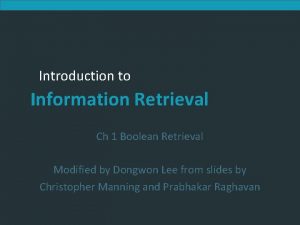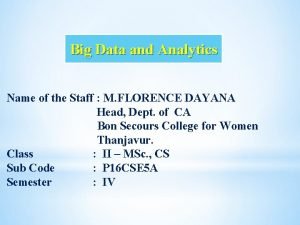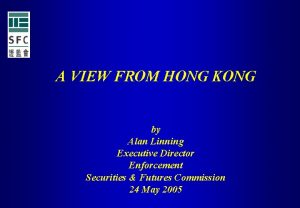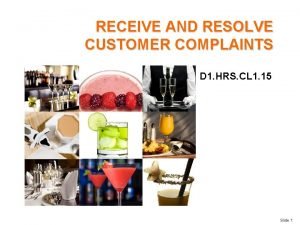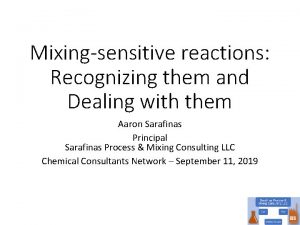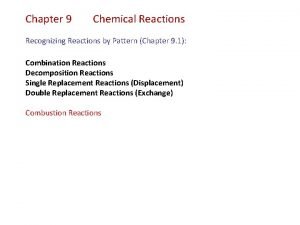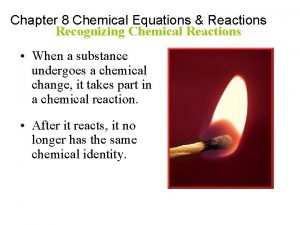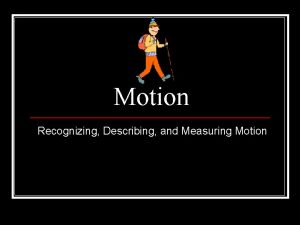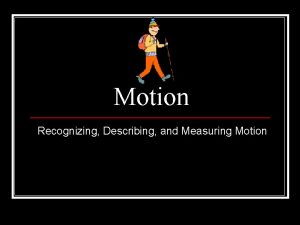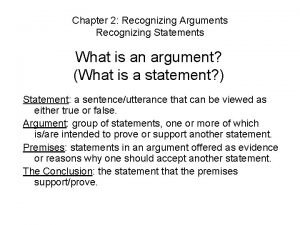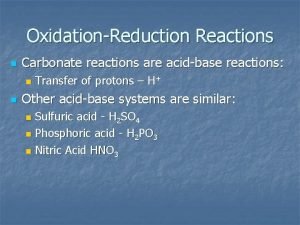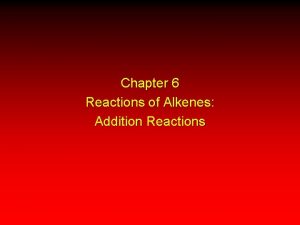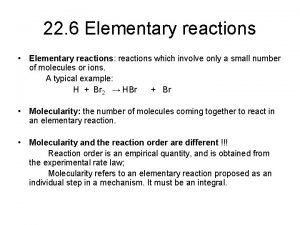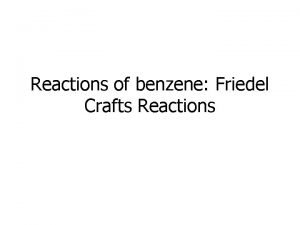Mixingsensitive reactions Recognizing them and Dealing with them
























































- Slides: 56

Mixing-sensitive reactions: Recognizing them and Dealing with them Aaron Sarafinas Principal Sarafinas Process & Mixing Consulting LLC Chemical Consultants Network – September 11, 2019

Raise your hand if you… • Are a chemist… An engineer… Other scientist… Other… • Ever took a process to a different scale (Scaled up or scaled down) • And never had a problem with scaling a process up or down • Ever “set the mixing” for your process • Using the Goldilocks (“this looks just right”) method • Using another non-visual method to get the right process response • Process Development is a dialogue between disciplines, so expect to share your opinions tonight Chemical Consultants Network Meeting, Bala Cynwyd, PA - 11 -September-2019 2

Why listen to me talk about mixing and process development? • Over 35 years experience with Dow / Rohm and Haas • Really a process development person, specializing in mixing Much taller in person • “Good mixing” is impossible without the proper process context. • Use the right tools in the right way at the right time to build process understanding and achieve commercial success. • Process developer who was bitten by the mixing bug… • Development, scale-up, commercialization, and troubleshooting for many products and processes for a variety of businesses • Starting with scale-up of suspension polymerization reactors • Many different multiphase contacting and reaction systems • Expertise in building process understanding and simplifying processes • Developed and delivered training on scale-up and mixing technology • Technical presentations at various AICh. E meetings • Contributor to the NAMF handbook Advances in Industrial Mixing Chemical Consultants Network Meeting, Bala Cynwyd, PA - 11 -September-2019 3

Sarafinas Process & Mixing Consulting LLC • Elected to retire from Dow in May 2018 • Started consulting company enabling clients to • Achieve faster process development and scaling, and • Leverage advantaged mixing technology • Services: • • • Experienced Problem Solving Faster Process Development / Faster Troubleshooting Does Mixing Matter? Simpler and Improved Processes Managing Technical Capabilities Delivering Technical Training • For more info: http: //sarafinasprocess. com Chemical Consultants Network Meeting, Bala Cynwyd, PA - 11 -September-2019 4

Does Mixing Matter? Prove it doesn’t matter… • From Ed Paul’s presentation at the 2003 Process Development Symposium Reference: E. L. Paul, “Notes on Process Development: Pharmaceutical Intermediates and API’s, ” AICh. E Process Development Division Symposium, Pocono Mountain, PA, June 2003. Chemical Consultants Network Meeting, Bala Cynwyd, PA - 11 -September-2019 5

This presentation will… Start with a simple competitive reaction Discuss relative mixing rates and reaction rates Look at a sanitized process and express our concerns Consider some reactions from the literature where mixing intensity can drive reaction selectivity • Discuss a simple experimental method (“The Bourne Protocol”) which can indicate when mixing matters • • • Identifying the critical mixing environment early in process development • With some quick examples where this protocol was applied to other competitive rate systems (like precipitation and crystallization) to enable successful scaling • Wrap up with some thoughts about future needs Chemical Consultants Network Meeting, Bala Cynwyd, PA - 11 -September-2019 6

This presentation will… • NOT be an overview of mixing technology • If you want that, check out my three-part webinar series for Dyno. Chem, available at Dyno. Chem Resources (https: //dcresources. scale-up. com/#q=Sarafinas+Talking+Mixing) • But I will mention some excellent mixing references • NOT be a detailed review of the Bourne Protocol • If you want that, check out two webinars I did in 2018 for Scientific Update and Dyno. Chem • But I will describe how the Bourne Protocol should be used to efficiently understand mixing sensitivities early in development • Start with a quiz… Chemical Consultants Network Meeting, Bala Cynwyd, PA - 11 -September-2019 7

You studied these, right? • (“HIM”) Paul, E. L. , V. A. Atiemo-Obeng, S. M. Kresta, Handbook of Industrial Mixing: Science and Practice, John Wiley and Sons, 2004. • (“AIM”) Kresta, S. M. , A. W. Etchels III, D. S. Dickey, V. A. Atiemo-Obeng, Advances in Industrial Mixing: A Companion to the Handbook of Industrial Mixing, John Wiley and Sons, 2016. • Bourne J. R. , “Mixing and the Selectivity of Chemical Reactions”, Org. Process Res. Dev. ; 2003; 7(4) pp. 471 -508. • Hope you all studied for the quiz… Chemical Consultants Network Meeting, Bala Cynwyd, PA - 11 -September-2019 8

A quiz? I came for dinner and networking… • In scaling mixing systems, what are three scales of interest? 1. ________________ 2. ________________ 3. ________________ Chemical Consultants Network Meeting, Bala Cynwyd, PA - 11 -September-2019 9

Consider this reaction system A + B R (desired product) • Competitive-Consecutive or Series-Parallel Reactions R + B S (undesired impurity) • How can we minimize losses to S? • Get the charges to be stoichiometrically appropriate • Excess B will make S • Order of addition • Add A to B? • Add B to A? • Having more B around leads to more S • OK, that’s rather elementary (even for an engineer), but what does this have to do with mixing? A B B A R S Chemical Consultants Network Meeting, Bala Cynwyd, PA - 11 -September-2019 10

So, what is “mixing? ” • My favorite definition of “mixing” • A process operation where mechanical energy induces fluid motion in a volume of fluid in order to Concentration Temperature Density reduce inhomogeneities of the fluid’s properties Viscosity to achieve a desired process result Suspension Drop size Chemical Consultants Network Meeting, Bala Cynwyd, PA - 11 -September-2019 11

Snapshots from the video • Colorization with an indicator dye t = 0. 5 s t = 1. 0 s t = 1. 8 s Decolorization of the dye with reagent t = 0 s t = 8 s t = 16 s Chemical Consultants Network Meeting, Bala Cynwyd, PA - 11 -September-2019 From “Talking Mixing: Basics of Mixing” (Sarafinas 2019) Images from FMP 12

Complexity of flow patterns t = 1. 0 s t = 0. 5 s Simple 2 D streamlines do not adequately represent the concentration gradients or the t = 1. 8 s details of the flows. Chemical Consultants Network Meeting, Bala Cynwyd, PA - 11 -September-2019 From “Talking Mixing: Basics of Mixing” (Sarafinas 2019) Images from FMP 13

What does it look like at “halftime? ” t = 0 s t = 16 s How is your process affected by the time it takes for the concentration t = 8 s gradients to disappear? Chemical Consultants Network Meeting, Bala Cynwyd, PA - 11 -September-2019 From “Talking Mixing: Basics of Mixing” (Sarafinas 2019) Images from FMP 14

Does mixing affect reactions? Sometimes • Consider only the first reaction A+B R with the rate expression • Does mixing affect the reaction rate? r. R = k 1[A][B] • “But since the composition is uniform throughout…” (Levenspiel, 1972, Chapter 5 “Steady-State Mixed-Flow Reactor”) • Does mixing affect the tank-average rate constant? • Does mixing affect the tank-average concentrations of A and B? • Mixing can affect the local reaction rate • How can mixing affect the local rate constant? • Temperature gradients in the vessel • How can mixing affect local concentrations? • Miscible liquid blending, as shown in the video • Mass transfer Chemical Consultants Network Meeting, Bala Cynwyd, PA - 11 -September-2019 15

Back to the competing reactions… • Process Scheme: • Reactions Competitive-Consecutive (Series-Parallel) Reactions • What happens if: • k 2 >> k 1? Only S • k 1 >> k 2? R is favored • But what happens in the feed zone, where [B] is high? • Doesn’t matter if k 2 >> k 1, still getting S • But if k 1 >> k 2, then the mixing probably will matter Chemical Consultants Network Meeting, Bala Cynwyd, PA - 11 -September-2019 16

A Sanitized Example • Suppose you want to make this molecule: “C” • From these materials “C” From Sarafinas, 2011 Chemical Consultants Network Meeting, Bala Cynwyd, PA - 11 -September-2019 17

First reaction: A+B R • Acid Chloride reacting with Amine… • “A” + “B” “R” HCl What’s missing? From Sarafinas, 2011 Chemical Consultants Network Meeting, Bala Cynwyd, PA - 11 -September-2019 Heat effects? 18

…but R+B S • Acid Chloride reacting with Amine… • “R” + “B” “S” HCl What’s missing? From Sarafinas, 2011 Chemical Consultants Network Meeting, Bala Cynwyd, PA - 11 -September-2019 Heat effects? 19

Consider the by-products • By-products in the reaction • Series-parallel or competitive-consecutive reactions • A + B R Don’t forget the HCl • R + B S (diacylated impurity) • Aqueous base fed to consume HCl by-product • Hydrolysis • Acid chloride + water or base Acid • Use organic solvent • Organic solvents can hydrolyze (with base or acid) From Sarafinas, 2011 Chemical Consultants Network Meeting, Bala Cynwyd, PA - 11 -September-2019 20

Consider the by-products • By-products in the first amidation reaction • R has an isomer from reacting on substituted amine • A + B R’ Is R or R’ favored? • R’ + B S (diacylated impurity) • Operating conditions affect selectivity • Temperature • Feed rates and concentrations • Mixing (competitive-consecutive reaction plus mass transfer) From Sarafinas, 2011 Chemical Consultants Network Meeting, Bala Cynwyd, PA - 11 -September-2019 Don’t forget the HCl 21

Conceptually, what goes on with fast competitive reactions Component B ADDED to BULK Component A Initial State (Completely Segregated) A A A A B B B B Competitive-Consecutive (Series-Parallel) Reactions A + B R (very fast) R + B S (slower) Chemical Consultants Network Meeting, Bala Cynwyd, PA - 11 -September-2019 22

Conceptually, what goes on with fast competitive reactions Component B ADDED to BULK Component A Initial State (Completely Segregated) A A A A B B B B Competitive-Consecutive (Series-Parallel) Reactions A + B R (very fast) R + B S (slower) The fraction of B that goes to “bad Stuff” Poor or Slow Mixing: t. M>>t. R first reacts, then mixes A A R R B B A S A A S S XS 1 (undesirable) A S Chemical Consultants Network Meeting, Bala Cynwyd, PA - 11 -September-2019 23

Conceptually, what goes on with fast competitive reactions Component B ADDED to BULK Component A Initial State (Completely Segregated) A A A A B B B B Poor or Slow Mixing: t. M>>t. R first reacts, then mixes A A R R B B A B A S R R A A S S XS 1 (undesirable) A S Competitive-Consecutive (Series-Parallel) Reactions A + B R (very fast) R + B S (slower) The fraction of B that goes to “bad Stuff” Ideal Mixing: t. M<<t. R first mixes, then reacts B A A B R R XS 0 (desirable) Chemical Consultants Network Meeting, Bala Cynwyd, PA - 11 -September-2019 B A R R 24

Compare Rates: Damkoehler Numbers • Chemical Consultants Network Meeting, Bala Cynwyd, PA - 11 -September-2019 25

How did you do on the quiz? • In chemical reaction scale-up, what are three scales of interest? • Not the lab, pilot plant, and plant. • One person’s lab is another’s production unit. • The three scales: macroscale, microscale, and mesoscale • Macroscale – Scale of the vessel and impeller • Microscale – Scale of the molecule, flow is no longer convective • Mesoscale – Scale of the fresh feed stream • These three scales allow us to think about mixing rates relative to reaction rates. Chemical Consultants Network Meeting, Bala Cynwyd, PA - 11 -September-2019 26

Damkoehler Numbers…ok…fine… • How? r rates? e h t o r o n io t my reac w o n rate k e ’t iv n o it t d e I p f i m t o a Wh what my c e in m r e t e d How can I ds? process nee Chemical Consultants Network Meeting, Bala Cynwyd, PA - 11 -September-2019 27

How can we find mixing sensitivities more efficiently for my process? • The “Bourne Protocol” is not a film… • Experimental protocol to determine mixing resistance • Reference: • The most comprehensive review article on the characterization of the influence of mixing on reaction selectivity. • Many examples of single phase and multiphase systems with mixing effects. Chemical Consultants Network Meeting, Bala Cynwyd, PA - 11 -September-2019 28

Mixing sensitive reactions in the literature • Bourne (2003) lists some common single phase and twophase reaction systems that show mixing sensitivities. • The four “Bourne Reactions” are mixing-sensitive reactions that have been used to characterize mixing systems. 1. Diazo coupling between 1 -naphthol and diazotized sulfanilic acid 2. Simultaneous diazo coupling between 1 - and 2 -naphthols and diazotized sulfanilic acid 3. Competitive neutralization of hydrochloric acid and alkaline hydrolysis of monochloroacetate esters with sodium hydroxide 4. Competitive neutralization of sodium hydroxide and acid hydrolysis of 2, 2 -dimethoxypropane with hydrochloric acid • Three papers at NAMF MIXING XXVI in June 2018 used the 4 th Bourne reaction to characterize their reactor configuration • Other reactions have been used including the Villermaux. Dushman reactions (boric acid, iodine, iodate system) Chemical Consultants Network Meeting, Bala Cynwyd, PA - 11 -September-2019 29

Typical results from Bourne (2003) The fraction of added B that goes to “bad Stuff” A + B R (very fast) R + B S (slower) • Mesomixing control • Xs sensitive to feed rate (local feed velocity) • Micromixing control • Xs insensitive to feed rate (local feed velocity) Chemical Consultants Network Meeting, Bala Cynwyd, PA - 11 -September-2019 30

Mixing sensitive reactions in the literature Competitive Reactions Competitive-Consecutive (Series-Parallel) Reactions • Reaction System A + B R (fast, desired) R + B S (slower, undesired) C + B S (slower, undesired) • Examples • 1 st Bourne Reaction • Villermaux-Dushman • 3 rd Bourne Reaction • 4 th Bourne Reaction • The 2 nd Bourne Reaction is an interesting hybrid of the Competitive-Consecutive and Competitive Reactions • Practical aspects of using the Bourne Reactions (along with typical rate constants) are discussed in HIM (2004) Chemical Consultants Network Meeting, Bala Cynwyd, PA - 11 -September-2019 31

“Sanitized” Project Team Studied Mixing Effects Bourne Parameter The fraction of added B that goes to “bad Stuff” Reference: A. Sarafinas, “Successful Process Development: Profitable Specialty Chemical Products Using Winning Work Practices, ” AICh. E Process Development Division Symposium, Pocono Mountain, PA, June 2003. 32 Chemical Consultants Network Meeting, Bala Cynwyd, PA - 11 -September-2019

“an interesting hybrid…” • 2 nd Bourne Reaction (Bourne 2003) A+B o-R A +B p-R B+o-R S B+p-R S B+C Q k= 12000 m 3 mol-1 s-1 k= 900 m 3 mol-1 s-1 k= 2 m 3 mol-1 s-1 k= 22 m 3 mol-1 s-1 k= 125 m 3 mol-1 s-1 A C +B +B +B o-R +B p-R +B S Q • Practical aspects of using the Bourne Reactions (along with typical rate constants) are discussed in HIM (2004) • How well do you know your process rate constants? • Why use a model reaction system when you can test mixing sensitivities with your own reaction system? • What if the competing rate process is a physical rate process (like a phase change) instead of a reaction? Chemical Consultants Network Meeting, Bala Cynwyd, PA - 11 -September-2019 33

Bourne (2003) Experimental Protocol The feed time for a semibatch reactor is usually so long that macromixing is not controlling. – Bourne (2003) Chemical Consultants Network Meeting, Bala Cynwyd, PA - 11 -September-2019 34

Bourne (2003) Experimental Protocol Chemical Consultants Network Meeting, Bala Cynwyd, PA - 11 -September-2019 35

Typical results from Bourne (2003) A + B R (very fast) R + B S (slower) • Sensitivities studied • Impeller speed The fraction of A that goes to “bad Stuff” • N ↑, Xs ↓ • Feed rate • Rate sensitive regime (mesomixing control) • Rate insensitive regime (micromixing control) • Feed location • eloc ↑, Xs ↓ • Number of feed points • Local feed velocity effects • Lower local velocity, Xs ↓ • More feed points at same local velocity, same Xs at shorter feed time Chemical Consultants Network Meeting, Bala Cynwyd, PA - 11 -September-2019 36

Bourne (2003) recommendations on how to scale • For constant reaction selectivity, constant Xs, or constant yield of “bad stuff”: • Micromixing control • Hold energy dissipation (local power per unit volume) constant where the mixing and reaction occur. • Mesomixing control • Keep impeller speed constant ($$$$) • Or extend the feed time (maybe $$$) • Crystallization literature suggests constant feed time / mesomixing time (Torbacke and Rasmusson, 2004) • Macromixing control • High blending efficiency • Hydrofoil impellers • Static mixers Chemical Consultants Network Meeting, Bala Cynwyd, PA - 11 -September-2019 37

What’s really going on inside this protocol • Controlled experiments to balance mixing time constants • Micromixing • Mesomixing • Protocol in Bourne (2003) Stirrer speed sensitivity No Mixing Unimportant No Micromixing Controlled No Macromixing Controlled Yes Feed Rate sensitivity Yes • Macromixing • Blend time = f(eavg, fluid properties, geometry) Feed Location sensitivity Yes Mesomixing Controlled Chemical Consultants Network Meeting, Bala Cynwyd, PA - 11 -September-2019 38

What’s really going on inside this protocol Revised Bourne Protocol • Controlled experiments to balance mixing time constants • Micromixing • Mesomixing • My Revision of the Protocol in Bourne (2003) Stirrer speed sensitivity • Blend time = f(eavg, fluid properties, geometry) Mixing Unimportant No Not meso. Likely micro- Yes Feed Rate sensitivity • Macromixing No Yes, meso. Execute mixing matters! Level 3 Anyway! Feed Location No sensitivity Unlikely Yes Result Better Process Response? Chemical Consultants Network Meeting, Bala Cynwyd, PA - 11 -September-2019 39

Does Mixing Matter? Prove it doesn’t matter… • From Ed Paul’s presentation at the 2003 Process Development Symposium Reference: E. L. Paul, “Notes on Process Development: Pharmaceutical Intermediates and API’s, ” AICh. E Process Development Division Symposium, Pocono Mountain, PA, June 2003. Chemical Consultants Network Meeting, Bala Cynwyd, PA - 11 -September-2019 40

We’ve had successes using this protocol for MANY competitive rate processes. • It’s not just for reactions anymore…but applicable any time concentration gradients can drive parallel physical processes. • Reactive precipitation / controlled crystallization showed sensitivity to impeller speed, feed rate, and feed location on particle size and filterability (Sarafinas and Teich in AIM 2016) • Understood critical process conditions for scalable coagulation and agglomeration processes using the Bourne Protocol, enabling pilot scale troubleshooting to resolve production scale issues. (Sarafinas, 2017) • Benefits of the Bourne Protocol • Running the real process • Efficient - step out when conclusion reached • Can be adapted to flow systems • “Sanitized” process would have gotten better process understanding sooner if we had the Bourne Protocol Chemical Consultants Network Meeting, Bala Cynwyd, PA - 11 -September-2019 41

Where do we go from here? • Competitive-Consecutive (Series-Parallel) and Competitive reactions can be mixing sensitive. • Multiphase systems can be mixing sensitive. • Use the Bourne Protocol to understand mixing sensitivities early in process development. • “Always assume there is a mixing problem until proven otherwise” • “Scale-up will make it worse” • Bourne Protocol factor settings based on scale-down from plant • Process Development is a dialogue between disciplines • What’s next • How best to characterize the micromixing-mesomixing space for process scaling? (Paper at AICh. E National Meeting Nov 2019) Chemical Consultants Network Meeting, Bala Cynwyd, PA - 11 -September-2019 42

Thank you! http: //sarafinasprocess. com aaron@sarafinasprocess. com Chemical Consultants Network Meeting, Bala Cynwyd, PA - 11 -September-2019 43

Appendix References Other back-up slides for further discussion Chemical Consultants Network Meeting, Bala Cynwyd, PA - 11 -September-2019 44

Three Key References • Bourne J. R. , “Mixing and the Selectivity of Chemical Reactions”, Org. Process Res. Dev. ; 2003; 7(4) pp. 471 -508. • (“HIM”) Paul, E. L. , V. A. Atiemo-Obeng, S. M. Kresta, Handbook of Industrial Mixing: Science and Practice, John Wiley and Sons, 2004. • (“AIM”) Kresta, S. M. , A. W. Etchels III, D. S. Dickey, V. A. Atiemo-Obeng, Advances in Industrial Mixing: A Companion to the Handbook of Industrial Mixing, John Wiley and Sons, 2016. Chemical Consultants Network Meeting, Bala Cynwyd, PA - 11 -September-2019 45

Other References • Davies, J. T. , “A physical interpretation of drop sizes in homogenizers and agitated tanks…”, Chem. Eng. Sci. , 42, pp. 1671 -1676 (1987). • Levenspiel, O. , Chemical Reaction Engineering, John Wiley and Sons, 1972. • Paul, E. L. , “Notes on Process Development: Pharmaceutical Intermediates and APIs, ” AICh. E Process Development Symposium, Poconos-Lake Harmony, PA, 2003 • Sarafinas, A. “A further look at the Bourne Protocol for efficient investigation of mixing sensitivities during process development, ” AICh. E 2017 Process Development Symposium, Toronto, Canada, June 2017. • Sarafinas, A. “The evolution of process understanding through micromixing and mass transfer studies in the successful development of a specialty chemical process, ” AICh. E 2011 Annual Meeting, Minneapolis MN, October 2011. Chemical Consultants Network Meeting, Bala Cynwyd, PA - 11 -September-2019 46

Other References • Sarafinas, A. “Successful Process Development: Profitable Specialty Chemical Products Using Winning Work Practices, ” AICh. E Process Development Symposium, Pocono Mountain, PA, June 2003. • Teich, C. I. , A. Sarafinas, P. M. Morton, AICh. E 2010 Annual Meeting, Salt Lake City, UT, November 2010 (2 papers): • “Can this process be saved? A search for understanding using the Bourne Protocol and advanced process development tools” • “Taking the min to the max: a case study in small scale process development using on-line reaction calorimetry and in-situ particle characterization” • Torbacke, M. , A. C. Rasmusson, “Mesomixing in Semi-Batch Reaction Crystallization and Influence of Reactor Size” AICh. E Journal 50 (2004) 3107 -3119. Chemical Consultants Network Meeting, Bala Cynwyd, PA - 11 -September-2019 47

Estimates of mixing parameters – a brief word of caution… • All mixing calculations that any software provides are estimates of mixing parameters. • Based on your inputs • Geometry • Physical properties • Based on the validity of the approaches used in the software • Engineering correlations based on experimental results • Other physical models • Use of any software does not allow the user to turn one’s brain off • This is an ideal time for chemist-engineer collaboration! • Use the estimates of mixing parameters for comparative purposes Chemical Consultants Network Meeting, Bala Cynwyd, PA - 11 -September-2019 48

If your process response is better at higher e Then you may need a different device… "Davies Plot" of local intensity of mixing devices Data and line from HIM(2004) Device ranges from Davies (1987), Bourne (2003), HIM(2004) Consider higher power per unit mass if appropriate for your plant equipment and process requirements 1000 maximum drop size, microns 100 10 Colloid mill Static Mixer Agitated Tank Ultrasonics Rotor-stator Centrifugal 1 pumps Turbulent jet Empty tube 0. 1 1 E+00 Liquid Whistles 1 E+01 1 E+02 1 E+03 Valve Homogenizers 1 E+04 1 E+05 local power per unit mass, W/kg 1 E+06 1 E+07 At a given impeller speed, local power per unit mass in an agitated tank can vary by a factor of 20 x or more! Chemical Consultants Network Meeting, Bala Cynwyd, PA - 11 -September-2019 1 E+08 1 E+09 49

Bourne Level 1 Experiment: How do I choose my impeller speeds? • Remember, we’re really changing the power per unit mass • If considering existing plant equipment, use the plant condition as the center point • Use a limiting condition • For minimum impeller speeds • Solid-liquid systems Njs • Liquid-liquid systems Njd • Gas-liquid systems flooding condition • For maximum impeller speed • Surface aeration • Default centerpoint • Vessel average power per unit mass = 0. 2 W/kg (1 HP/1000 US gal) • Set upper and lower vessel average power per unit mass at 10 x and 0. 1 x the centerpoint power per unit mass. Chemical Consultants Network Meeting, Bala Cynwyd, PA - 11 -September-2019 50

Bourne Level 2 Experiments: How do I choose my feed rates? • Fastest safe and practical plant scale feed rate as midpoint • For pumping and piping limits • Heat transfer limitations for exothermic reactions or heat of dilution • Use as midpoint to assess potential effect of higher and lower feed rates • Are we on the left-hand side of that Xs vs tf curve? • How does mesomixing scale up? • Bourne considers constant ts, but that’s too conservative. • Some crystallization literature suggests scaling on (feed time) / (mesomixing time) • Mentioned in a paper at NAMF MIXING XXVI • Key reference Torbacke and Rasmusson (2004) • Not comfortable with their definition of mesomixing time • Under study by the FMP consortium Chemical Consultants Network Meeting, Bala Cynwyd, PA - 11 -September-2019 51

Bourne Level 3 Experiment: How do I choose my feed location? • Local power per unit mass vs average power per unit mass • Consider literature resources • Consider rules of thumb (Dyno. Chem) • Surface feed eloc/eavg = 0. 1 • Sub-surface feed eloc/eavg = 1 • Impeller zone feed eloc/eavg = 2 • Consider quick CFD analysis • How to choose? • Consider the plant configuration • Consider the consequences of feed-pipe backmixing • Consider Ed Paul’s 3 rd rule of mixing: Subsurface addition for reaction and crystallization – prove it’s not needed! Chemical Consultants Network Meeting, Bala Cynwyd, PA - 11 -September-2019 52

Chemical Consultants Network Meeting, Bala Cynwyd, PA - 11 -September-2019 53

“Sanitized” Production start-up results • Plant design formed minimal S • Only out of spec lot was when the 50% Na. OH feed pump broke From Sarafinas, 2011 Chemical Consultants Network Meeting, Bala Cynwyd, PA - 11 -September-2019 Pa ge 54

Similar “Sanitized” reaction system introduced to the same equipment • Minimal S formation • Note scale difference from previous slide • Deviations in batches 6 -8 from mis-matched feed rates • Long-term drift of [S] may be due to impurities in recycle solvent From Sarafinas, 2011 Chemical Consultants Network Meeting, Bala Cynwyd, PA - 11 -September-2019 Pa ge 55

Applications of micromixing design concepts to multiphase systems for “Sanitized” process • Fortunately, both micromixing and interfacial area scale with power per unit mass • Feed dispersed phase to impeller region to maximize area generation • Avoid feedpipe backmixing From Sarafinas, 2011 Chemical Consultants Network Meeting, Bala Cynwyd, PA - 11 -September-2019 Pa ge 56
 Section 2 classifying chemical reactions
Section 2 classifying chemical reactions Redox reaction example
Redox reaction example Section 2 reinforcement classifying chemical reactions
Section 2 reinforcement classifying chemical reactions Types of reactions
Types of reactions Unit 5 chemical reactions answers
Unit 5 chemical reactions answers What are useful materials at home
What are useful materials at home Trends and opportunities examples
Trends and opportunities examples An opportunity has four essential qualities it is
An opportunity has four essential qualities it is Recognizing opportunities and generating ideas
Recognizing opportunities and generating ideas Recognizing and resolving abo discrepancies
Recognizing and resolving abo discrepancies Listening answer
Listening answer Recognizing opportunities and generating ideas
Recognizing opportunities and generating ideas Recognizing cognates in listening
Recognizing cognates in listening Chapter 3 recognizing opportunity
Chapter 3 recognizing opportunity Recognizing genre - argumentative text
Recognizing genre - argumentative text Channel design meaning
Channel design meaning Recognizing lab safety worksheet answer key
Recognizing lab safety worksheet answer key Chapter 3 recognizing opportunity
Chapter 3 recognizing opportunity Strategy: recognizing cognates
Strategy: recognizing cognates The argumentative essay is a genre of writing that requires
The argumentative essay is a genre of writing that requires Chapter 3 recognizing opportunity
Chapter 3 recognizing opportunity Recognizing laboratory safety
Recognizing laboratory safety Identifying and correcting faulty sentences
Identifying and correcting faulty sentences Personal pronouns
Personal pronouns Recognizing interruptions of health development
Recognizing interruptions of health development Recognizing patterns of organization
Recognizing patterns of organization Chapter 13 worksheet recognizing different sports injuries
Chapter 13 worksheet recognizing different sports injuries The hot july sun beat relentlessly down
The hot july sun beat relentlessly down Channel design meaning
Channel design meaning Chapter 3 recognizing opportunity
Chapter 3 recognizing opportunity Adverb of happy
Adverb of happy Recognizing a firm's intellectual assets
Recognizing a firm's intellectual assets Chapter 5 lesson 1 dealing with anxiety and depression
Chapter 5 lesson 1 dealing with anxiety and depression Chapter 5 lesson 1 dealing with anxiety and depression
Chapter 5 lesson 1 dealing with anxiety and depression If you can t beat them join them
If you can t beat them join them Assimilation linguistics
Assimilation linguistics What is abiotic factor
What is abiotic factor Section 2 dealing with other nations
Section 2 dealing with other nations Contact center stress
Contact center stress Market follower
Market follower It is a genre of speculative fiction dealing
It is a genre of speculative fiction dealing Dealing with competition marketing management
Dealing with competition marketing management Unit 1 dealing with incoming calls
Unit 1 dealing with incoming calls Dealing with anger bible
Dealing with anger bible Dealing successfully with difficult changes in your life.
Dealing successfully with difficult changes in your life. Lexicology as a branch of linguistics
Lexicology as a branch of linguistics A play with a sad or unhappy ending
A play with a sad or unhappy ending Dealing with unstructured data
Dealing with unstructured data Reuters dealing manual
Reuters dealing manual Dealing with unstructured data
Dealing with unstructured data The branch of zoology dealing with insects
The branch of zoology dealing with insects The branch of zoology dealing with insects
The branch of zoology dealing with insects Dealing with challenging patients
Dealing with challenging patients Dealing successfully with difficult changes
Dealing successfully with difficult changes Dealing with unstructured data
Dealing with unstructured data Alan linning
Alan linning Resolve hrs
Resolve hrs







